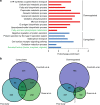Genetically diverse Pseudomonas aeruginosa populations display similar transcriptomic profiles in a cystic fibrosis explanted lung
- PMID: 31363089
- PMCID: PMC6667473
- DOI: 10.1038/s41467-019-11414-3
Genetically diverse Pseudomonas aeruginosa populations display similar transcriptomic profiles in a cystic fibrosis explanted lung
Abstract
Previous studies have demonstrated substantial genetic diversification of Pseudomonas aeruginosa across sub-compartments in cystic fibrosis (CF) lungs. Here, we isolate P. aeruginosa from five different sampling areas in the upper and lower airways of an explanted CF lung, analyze ex vivo transcriptional profiles by RNA-seq, and use colony re-sequencing and deep population sequencing to determine the genetic diversity within and across the various sub-compartments. We find that, despite genetic variation, the ex vivo transcriptional profiles of P. aeruginosa populations inhabiting different regions of the CF lung are similar. Although we cannot estimate the extent to which the transcriptional response recorded here actually reflects the in vivo transcriptomes, our results indicate that there may be a common in vivo transcriptional profile in the CF lung environment.
Conflict of interest statement
The authors declare no competing interests.
Figures






Similar articles
-
Fermentation products in the cystic fibrosis airways induce aggregation and dormancy-associated expression profiles in a CF clinical isolate of Pseudomonas aeruginosa.FEMS Microbiol Lett. 2018 May 1;365(10):fny082. doi: 10.1093/femsle/fny082. FEMS Microbiol Lett. 2018. PMID: 29617986 Free PMC article.
-
Extensive diversification is a common feature of Pseudomonas aeruginosa populations during respiratory infections in cystic fibrosis.J Cyst Fibros. 2013 Dec;12(6):790-3. doi: 10.1016/j.jcf.2013.04.003. Epub 2013 May 1. J Cyst Fibros. 2013. PMID: 23642644 Free PMC article.
-
In vitro evolution of Pseudomonas aeruginosa AA2 biofilms in the presence of cystic fibrosis lung microbiome members.Sci Rep. 2019 Sep 6;9(1):12859. doi: 10.1038/s41598-019-49371-y. Sci Rep. 2019. PMID: 31492943 Free PMC article.
-
Iron acquisition by Pseudomonas aeruginosa in the lungs of patients with cystic fibrosis.Biometals. 2009 Feb;22(1):53-60. doi: 10.1007/s10534-008-9197-9. Epub 2009 Jan 7. Biometals. 2009. PMID: 19130260 Review.
-
Microevolution of Pseudomonas aeruginosa to a chronic pathogen of the cystic fibrosis lung.Curr Top Microbiol Immunol. 2013;358:91-118. doi: 10.1007/82_2011_199. Curr Top Microbiol Immunol. 2013. PMID: 22311171 Review.
Cited by
-
Competitive fitness of Pseudomonas aeruginosa isolates in human and murine precision-cut lung slices.Front Cell Infect Microbiol. 2022 Aug 23;12:992214. doi: 10.3389/fcimb.2022.992214. eCollection 2022. Front Cell Infect Microbiol. 2022. PMID: 36081773 Free PMC article.
-
Systematic identification of molecular mediators of interspecies sensing in a community of two frequently coinfecting bacterial pathogens.PLoS Biol. 2022 Jun 21;20(6):e3001679. doi: 10.1371/journal.pbio.3001679. eCollection 2022 Jun. PLoS Biol. 2022. PMID: 35727825 Free PMC article.
-
Intraspecies Transcriptional Profiling Reveals Key Regulators of Candida albicans Pathogenic Traits.mBio. 2021 Apr 20;12(2):e00586-21. doi: 10.1128/mBio.00586-21. mBio. 2021. PMID: 33879584 Free PMC article.
-
CRISPRi screen identifies FprB as a synergistic target for gallium therapy in Pseudomonas aeruginosa.Nat Commun. 2025 Jul 1;16(1):5870. doi: 10.1038/s41467-025-61208-z. Nat Commun. 2025. PMID: 40595632 Free PMC article.
-
Transcriptional Profiling of Pseudomonas aeruginosa Infections.Adv Exp Med Biol. 2022;1386:303-323. doi: 10.1007/978-3-031-08491-1_11. Adv Exp Med Biol. 2022. PMID: 36258077 Review.
References
-
- Frimmersdorf E, Horatzek S, Pelnikevich A, Wiehlmann L, Schomburg D. How Pseudomonas aeruginosa adapts to various environments: a metabolomic approach. Environ. Microbiol. 2010;12:1734–1747. - PubMed
-
- de Bentzmann S, Plesiat P. The Pseudomonas aeruginosa opportunistic pathogen and human infections. Environ. Microbiol. 2011;13:1655–1665. - PubMed
-
- Gellatly SL, Hancock RE. Pseudomonas aeruginosa: new insights into pathogenesis and host defenses. Pathog. Dis. 2013;67:159–173. - PubMed
-
- Valentini M, Gonzalez D, Mavridou DA, Filloux A. Lifestyle transitions and adaptive pathogenesis of Pseudomonas aeruginosa. Curr. Opin. Microbiol. 2018;41:15–20. - PubMed
Publication types
MeSH terms
Substances
LinkOut - more resources
Full Text Sources
Medical
Molecular Biology Databases

